Fastest propeller-driven aircraft
A number of aircraft have been claimed to be the fastest propeller-driven aircraft. This article presents the current record holders for several sub-classes of propeller-driven aircraft that hold recognized, documented speed records in level flight. Fédération Aéronautique Internationale (FAI) records are the basis for this article.[1] Other contenders and their claims are discussed, but only those made under controlled conditions and measured by outside observers. Pilots during World War II sometimes claimed to have reached supersonic speeds in propeller-driven fighters during emergency dives, but these speeds are not included as accepted records. Neither are speeds recorded in a dive during high-speed tests with the Supermarine Spitfire, including Squadron Leader J.R. Tobin's 606 mph (975 km/h, Mach 0.89) in a 45° dive in a Mark XI Spitfire (date unknown) and Squadron Leader Anthony F. Martindale's breaking 620 mph (998 km/h, Mach 0.92) in the same aircraft in April 1944.[2] Flight Lieutenant Edward Powles' 690 mph (1110 km/h, Mach 0.96) in Spitfire PR.XIX PS852 during an emergency dive while carrying out spying flights over China on 5 February 1952 is also discounted. This would otherwise be the highest speed ever recorded for a piston-engined aircraft.[3]
Propeller versus jet propulsion
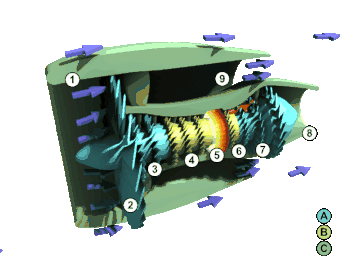
Aircraft that use propellers as their prime propulsion device constitute a historically important subset of aircraft, despite inherent limitations to their speed. Aircraft powered by piston engines get virtually all of their thrust from the propeller driven by the engine. A few piston engined aircraft derive some thrust from the engine's exhaust gases, and there are certain hybrid types like the Motorjet that use a piston engine to drive the compressor of a jet engine, which supplies the primary thrust (although some types also have a propeller powered by the piston engine for low speed efficiency). All aircraft prior to World War II (except for a tiny number of early jet aircraft and rocket aircraft) used piston engines to drive propellers, so all Flight airspeed records prior to 1944 were necessarily set by propeller-driven aircraft. Rapid advances in first liquid-fueled rocket engine-powered aircraft – with a 1004 km/h record set in October 1941 by a German example — and axial-flow jet engine technology during World War II meant that no propeller-driven aircraft would ever again hold an absolute air speed record. Shock wave formation in propeller-driven aircraft at speeds near sonic conditions, impose limits not encountered in jet aircraft.
Jet engines, particularly turbojets, are a type of gas turbine configured such that most of the work available results from the thrust of the hot exhaust gases. Turbofans, both the high-bypass versions used in all modern commercial jetliners, and the low-bypass versions in most modern military aircraft, produce a combination of jet thrust from the exhaust of burnt fuel, and air thrust from what amounts to an internal propeller. High-bypass turbofan engines achieve most of their thrust from a fan driving air backwards through the engine casing, and driven by a gas turbine, which also contributes jet thrust via its exhaust. The two are in one large engine casing with the fan (propeller) at the front and the jet engine behind, with both turbine exhaust and fan-driven air exiting the rear of the engine casing. Turboprop engines are similar, but use an external propeller rather than an internal fan (propeller) inside an engine casing. The hot exhaust gas from a turboprop engine gives a small amount of thrust, however the propeller is the main source of thrust.
Turboprops
The FAI lists a Piaggio P.180 Avanti as the fastest propeller-driven aircraft with speed of 927.4 km/h “over a recognized course”, in this case Fort Worth to Atlanta, set on 6 Feb 2003 by Joseph J. Ritchie.[4]
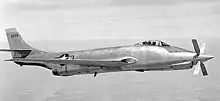
Probably the fastest aircraft ever fitted with an operating propeller was the experimental McDonnell XF-88B, which was made by installing an Allison T38 turboshaft engine in the nose of a pure jet-powered XF-88 Voodoo. This unusual aircraft was intended to explore the use of high-speed propellers and achieved supersonic speeds.[5] This aircraft is not considered to be propeller-driven since most of the thrust was provided by two jet engines.
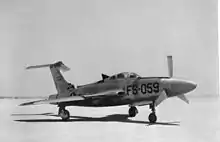
An oft-cited contender for the fastest propeller-driven aircraft is the XF-84H Thunderscreech. This aircraft is named in Guinness World Records, 1997, as the fastest in this category with a speed of 623 mph (1,002 km/h, Mach 0.83).[6] While it may have been designed as the fastest propeller-driven aircraft, this goal was not realized due to its inherent instability.[7] This record speed is also inconsistent with data from the National Museum of the United States Air Force, which gives a top speed of 520 mph (837 km/h, Mach 0.70),[8] slower than the current record.
Piston engines
_Rare_Bear_2014_Reno_Air_Races.jpg.webp)
The more "traditional" class of propeller-driven aircraft comprises those powered by piston engines, which include nearly all aircraft from the Wright brothers up through World War II. Today piston engines are used almost exclusively on light, general aviation aircraft. The official speed record for a piston plane was held by a modified Grumman F8F Bearcat, the Rare Bear, with a speed of 528.315 mph (850.241 km/h) on 21 August 1989 at Las Vegas, New Mexico, United States of America.[9][10] This record was retired as a new weight class based system was introduced to allow more pilots to set new records across a wider range of aircraft. On September 2, 2017, Steve Hinton Jr, in the modified P-51 Mustang Voodoo set the new record of 531.53 mph (855.41 km/h) in the C-1e class (the same weight class Rare Bear would fall into). This record is also the fastest for any propeller driven piston aircraft.
The FAI record for the fastest piston-powered aircraft over a long-distance circuit is the 2000-km record of 447.5 mph (720.2 km/h) set on 22 May 1948 by Jacqueline Cochran in a P-51C. (She also holds the 100-km record of 469.55 mph, set in December 1947.) Higher speed records exist; some are unofficial and some were officially-timed one-way trips aided by tailwinds. Examples of the latter: a B-29 averaged 450 mph (724 km/h) from Burbank to Floyd Bennett Field (2460 mi in 5.455 hours) on 11 December 1945, and Joe DeBona averaged 561.57 mph (904 km/h) from Los Angeles LAX to New York Idlewild (2475 mi (3981.5 km) in 4.405 hours) in a P-51 on 30 March 1954. On September 12, 2003, the modified P-51 Dago Red, piloted by Skip Holm, averaged 507.105 mph (816.1 km/h) during the 6 lap (c.50 miles) Reno Air Races Friday Gold Race.
Other claimants
The 1903 Wright Flyer did 30 mph (48 km/h) during its first flight; the Bleriot XI reached 47 mph (76 km/h) in 1909. Fabric-covered biplanes of the World War I era and shortly after could do up to 200 mph (320 km/h). In 1925 U.S. Army Lt. Cyrus K. Bettis flying a Curtiss R3C won the Pulitzer Trophy Race with a speed of 248.9 mph (400.6 km/h).[11]
Speeds of all-metal monoplanes of the 1930s jumped into the 435 mph (700 km/h) range with the Macchi M.C.72 reaching a top speed of 440.6 mph (709.1 km/h), still the record for piston-powered seaplanes.[12] The Messerschmitt Me 209 V1 set a world speed record of almost 756 km/h (470 mph) on 26 April 1939,[13] and the Republic XP-47J (a variant of the P-47 Thunderbolt) is claimed to have reached 505 mph (813 km/h) in testing. The P-51H Mustang, 555 made, could go 487 mph (784 km/h). The prototype of the twin-engined de Havilland Hornet (RR915) (383 built) reached 485 mph (781 km/h) as did a prototype Hawker Fury (LA610) when fitted with a Napier Sabre VII, and a prototype of the successor to the Supermarine Spitfire, the Supermarine Spiteful F.16 (RB518), reached 494 mph (795 km/h). The fastest German propeller driven aircraft that flew in WWII (did not see combat) was the twin-DB 603-powered Dornier Do 335 "Pfeil/Arrow" which had a claimed top speed of 474 mph (763 km/h).[14]
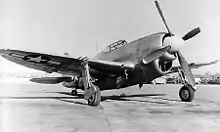
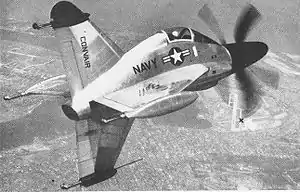
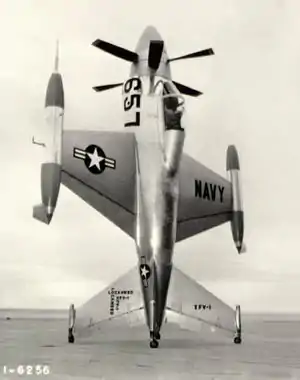
During the 1950s two unorthodox United States Navy fighter prototypes married turboprop engines with a "tailsitting design", the Convair XFY "Pogo" and the Lockheed XFV. Maximum design speeds of 610 mph (980 km/h) at 15,000 ft (4,600 m) and 578 mph (930 km/h) respectively have been quoted. The Lockheed XFV was fitted with a less powerful engine than it was designed for and had makeshift non-retractable landing gear for horizontal takeoff and landing;[15] the Convair's landing gear supported it in a vertical position. It was usually flown with the cockpit open, since the ejection seat was thought unreliable.[16] These aircraft had "compromised in-flight speed" because of the conflicting demands of vertical and horizontal flight.[17]
References
Notes
- "FAI official database" Fédération Aéronautique Internationale. Retrieved: 5 September 2007.
- The Spitfires That Nearly Broke The Sound Barrier, BBC
- Spitfire Timeline
- "FAI record 7627". Retrieved 4 September 2020.
- "NASA History pages." NASA. Retrieved: 4 September 2007.
- Young 1997, p. 137.
- Hendrix 1977, p. 408. Quote: The XF-84H never achieved its designer's dreams of being the first propeller-driven aircraft to attain supersonic flight. In fact, it never flew over 450 kt indicated, since at that speed, it developed an unhappy practice of 'snaking', apparently losing longitudinal stability. NOTE: 450 kt=518 mph
- "XF-84H Fact sheet." Archived 2013-03-06 at the Wayback Machine USAF. Retrieved: 3 April 2009.
- "'Rare Bear' web site." Rare Bear Air Race Team, 2008. Retrieved: 13 November 2007.
- www.AeroSpaceWeb.org "Aircraft speed records." Aerospaceweb. Retrieved: 13 November 2007.
- Taylor and Munson 1973, p. 243.
- Taylor and Munson 1973, p. 245.
- Green, 1970, p. 607.
- Green, 1970, p.162
- "Lockheed FXV data." globalsecurity. Retrieved: 24 February 2009.
- "Data for Convair XFY." National Air and Space Museum. Retrieved: 24 February 2009.
- Hite, Kennith F., Lieutenant Colonel. "Why the VTOL Fighter?" Air University Review, US Air Force Air University, July–August 1968. Retrieved: 15 January 2011.
Bibliography
- Darling, Kev. Griffon Powered Spitfires (Warbird Tech Series). North Branch, Minnesota: Specialty Press, 2001. ISBN 1-58007-045-0.
- Green, William. Warplanes of the Third Reich. London: McDonald and Jane's Publishers Ltd, 1970. ISBN 0-356-02382-6.
- Gross, Nigel et al. Speed and Power: 100 Years of Change. North Vancouver, British Columbia, Canada: Whitecap Books, 1998. ISBN 978-1-55110-732-5.
- Hendrix, Lin. "Thunderscreech." Aeroplane Monthly Vol. 5, Issue 8, August 1977.
- Taylor, John W.R. and Kenneth Munson. History of Aviation. London: Octopus Books, 1973. ISBN 0-7064-0241-3.
- Young, Mark C., ed. The Guinness Book of Records 1997. North Salem, New York: Mint Publishers Group, 1997. ISBN 0-85112-014-8.